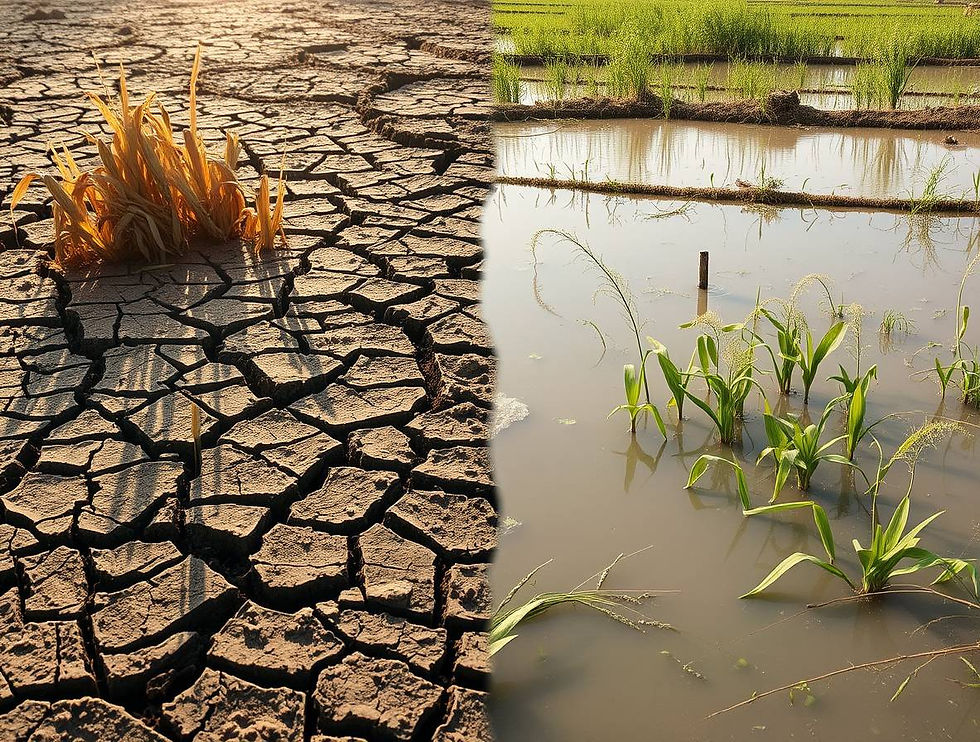The Climate Challenge in Agriculture: A Call for Resilient and Climate Smart Farming
- CYOL Press Release

- Aug 27
- 5 min read
By CYOL Staff
Agriculture is a foundational pillar of global food security, rural livelihoods, and economic stability. However, it is increasingly vulnerable to the accelerating impacts of climate change. Rising temperatures, unpredictable rainfall, prolonged droughts, and extreme flooding are disrupting traditional farming patterns, reducing yields, and placing unprecedented pressure on natural resources.
The urgency to act is clear. The United Nations Food and Agriculture Organization (FAO) projects that global food production must increase by 50% by 2050 to meet the needs of an estimated 9.7 billion people. Yet, without adaptation, climate change could reduce agricultural productivity by up to 30% in some regions. This is not only an environmental issue, but also a challenge with far-reaching social, economic, and humanitarian implications.

At the same time, agriculture is a significant contributor to the climate crisis, accounting for approximately 23% of global greenhouse gas emissions through deforestation, livestock methane emissions, and nitrous oxide emissions from fertilizers. The sector must therefore take on a dual responsibility: adapting to climate impacts while actively reducing its environmental footprint.
The solution lies in adopting resilient and climate smart farming practices that safeguard productivity, protect ecosystems, and strengthen the resilience of farming communities.
Understanding the Climate Agriculture Nexus
The relationship between climate change and agriculture is both direct and complex. The impacts are experienced differently across regions, yet the vulnerabilities share common threads:
Asia: Disrupted monsoon cycles create unpredictable wet and dry periods. In Sri Lanka, shifting rainfall patterns have affected the traditional Maha and Yala cultivation seasons, leaving farmers uncertain about planting schedules.
Africa: Persistent droughts in countries such as Kenya and Ethiopia are degrading pastureland, reducing crop yields, and intensifying food insecurity.
South America: Glacial melt in the Andes is reducing freshwater availability for irrigation in Peru and Bolivia, threatening high altitude agriculture.
Smallholder farmers, who produce over 70% of the world’s food, are disproportionately at risk. Limited access to financial resources, technology, and infrastructure makes it harder for them to adapt to changing conditions.
Agriculture also influences the climate. Large scale deforestation for crop cultivation releases significant carbon stores. Excessive fertilizer use produces nitrous oxide, a greenhouse gas with a global warming potential nearly 300 times greater than carbon dioxide, while livestock digestion generates methane, another potent heat trapping gas.
Addressing these dual challenges requires a structural transformation in how food is produced, distributed, and consumed.
The Role of Climate Smart Agriculture (CSA)
Climate smart agriculture is an integrated approach designed to address the interconnected challenges of food security and climate change. Developed with guidance from the FAO, CSA focuses on three core objectives:
1.Enhancing Productivity
Producing sufficient food for a growing global population requires improving efficiency while preserving natural resources. For example, in India, the System of Rice Intensification (SRI) method has enabled farmers to increase rice yields using less water, fewer seeds, and reduced chemical inputs.
2. Building Resilience
Resilience ensures that farming systems can withstand shocks such as extreme weather events, pest outbreaks, and market volatility. In Sri Lanka’s dry zone, short duration paddy varieties are now helping farmers adapt to erratic rainfall by maturing more quickly.
3. Reducing Emissions
CSA incorporates practices that minimize greenhouse gas emissions while enhancing carbon sequestration. In Kenya, integrating nitrogen fixing trees into maize fields has improved yields while storing atmospheric carbon in soils and biomass.
CSA is not prescriptive. Its strength lies in combining scientific innovation, traditional knowledge, and local adaptation to create context specific solutions.

Strategies for Resilient Farming
A transition to climate smart agriculture involves adopting a suite of evidence based strategies tailored to local ecosystems, crop types, and socio economic conditions.
1. Diversified Cropping Systems
Planting multiple crops, either together or in rotation, reduces vulnerability to climate variability. For example, intercropping maize and cowpea in Sri Lanka’s Kurunegala district has improved household resilience by diversifying income sources and enhancing soil fertility through nitrogen fixation.
2. Water Management
Efficient water use is essential in the face of growing scarcity. Techniques include:
Precision irrigation (e.g., drip or sprinkler systems) to deliver water directly to plant roots.
Rainwater harvesting to store runoff for use in dry periods.
Soil moisture monitoring to ensure irrigation is applied only when necessary.
Israel’s drip irrigation systems have transformed arid landscapes into productive farms. Similar technologies are now being piloted in Sri Lanka’s North Central Province to optimize water efficiency.
3. Improved Livestock Management
Sustainable livestock systems reduce emissions while supporting farmer livelihoods. Approaches include rotational grazing, improved feed composition, and better manure handling to produce biogas. In Vietnam, small scale biogas digesters are turning livestock waste into renewable household energy, lowering emissions and fuel costs.
4. Agroforestry
Integrating trees into farmland enhances biodiversity, improves soil structure, prevents erosion, and sequesters carbon. In Sri Lanka’s wet zone, pepper vines cultivated around Gliricidia sepium trees generate multiple revenue streams, spices, fuelwood, and organic mulch while improving ecosystem services.
5. Digital Tools and Data
Technological innovations are transforming on farm decision making. Mobile apps, AI based disease detection, and satellite monitoring provide farmers with actionable insights. In Kenya, the Plant Village Nuru application identifies plant diseases using AI, while in Sri Lanka, remote sensing is being used to track paddy cultivation and forecast drought stress.
The Path Forward: Building a Climate Smart Future
The transition to CSA cannot be achieved by farmers alone. It requires coordinated action from governments, the private sector, civil society, and international organizations.
Policy Support: National policies should promote CSA through targeted subsidies, favorable tax regimes, and infrastructure investments.
Capacity Building: Training, farmer field schools, and peer to peer knowledge exchange are essential to ensure adoption of best practices.
Private Sector Engagement: Agribusinesses can accelerate CSA adoption by developing affordable technologies, improving supply chain sustainability, and providing market access.
Global Collaboration: International development agencies and climate funds can provide financing, research support, and policy alignment across borders.
Case Studies in Climate Smart Success
Sri Lanka – Integrated Farming Systems: Farmers in Anuradhapura are combining paddy cultivation with vegetables, livestock, and agroforestry, reducing risk, and improving food and income security.
Kenya – Farmer Managed Natural Regeneration: This approach has restored millions of hectares of degraded land, increasing both productivity and biodiversity.
India – Zero Budget Natural Farming: In Andhra Pradesh, farmers are improving soil health and reducing input costs through chemical free methods, enhancing both resilience and profitability.
Addressing Barriers to Adoption

While the benefits of CSA are well documented, several challenges persist:
High Initial Costs: Technologies such as drip irrigation and solar powered pumps require upfront capital.
Knowledge Gaps: Many farmers are unaware of CSA benefits or lack the technical expertise to implement them.
Market Pressures: Demand for high yield crops can discourage the use of more resilient, traditional varieties.
Policy Misalignment: Subsidies for water, energy, or fertilizers can unintentionally promote unsustainable practices.
Overcoming these barriers requires targeted financing mechanisms, inclusive policy frameworks, and a commitment to participatory decision making, which places farmers at the center.
The climate challenge in agriculture is immediate and profound. It is already shaping the future of farming from Hambantota to Honduras. However, it also presents a historic opportunity to redesign food systems to be more sustainable, equitable, and climate resilient.
Adopting climate smart agriculture is not merely a technical shift; it is a transformation in how we value natural resources, support farming communities, and safeguard future generations. The time for incremental change has passed. What is needed now is decisive, coordinated action at all levels: local, national, and global.
Resilient, climate smart farming is not just about producing food. It is about ensuring the survival of ecosystems, protecting livelihoods, and building a secure, sustainable future for all.




























Comments